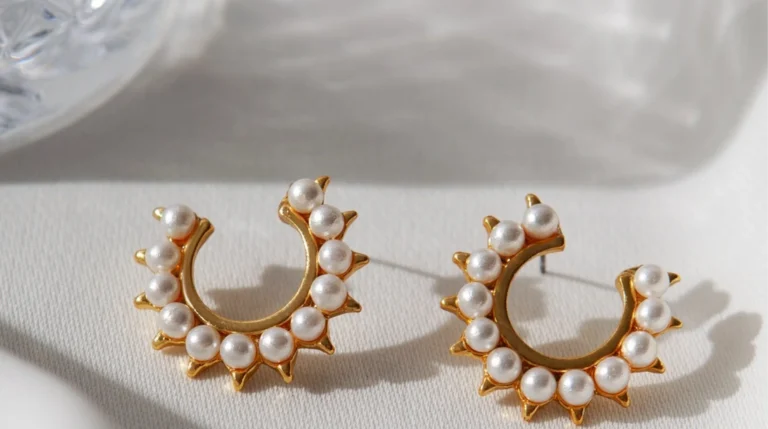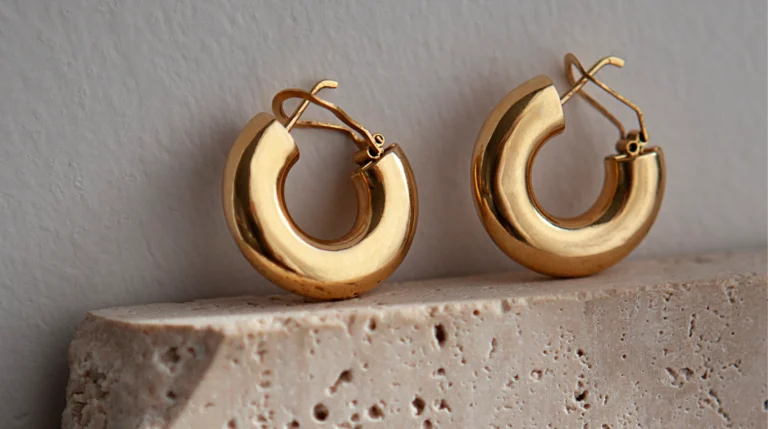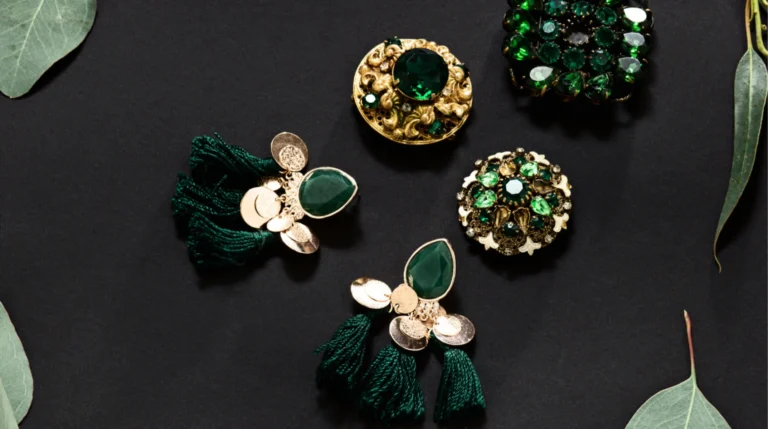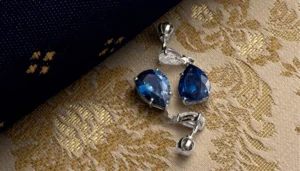In the dynamic world of e-commerce, where visual appeal plays a pivotal role in attracting customers, product photography is a critical component. When it comes to jewelry, especially earrings, the challenge intensifies due to their small size and intricate details. In this comprehensive guide, we will walk you through the essential steps and tips to master the art of earrings product photography, helping you showcase your jewelry in the best light possible.
Invest in quality equipment

The quality of the equipment used for earring product photography is crucial in capturing high-quality images that accurately showcase the design, color, and texture of the products.
Utilizing a DSLR camera with a high-resolution sensor and advanced features allows sharp and detailed images that highlight the intricacies of earrings. The advanced features of a DSLR, such as manual settings for exposure and focus, give you greater control over the final look of your product photos.
A macro lens is essential for capturing close-up shots of the earrings, showcasing their fine details and craftsmanship. A dedicated macro lens within the focal range of 50mm to 100mm is perfect for highlighting the fine details, such as tiny gemstones, delicate engravings, or intricate patterns. By focusing closely on the subject, you have flexibility in creating breathtaking images.
Proper lighting is crucial for product photography as it illuminates the earrings evenly and eliminates harsh shadows. A softbox or ring light provides controlled, diffused lighting that enhances the colors, textures, and shine of the earrings, creating a visually appealing image that draws in potential customers.
Additionally, using a backdrop in your product photography helps create a clean and professional look for your images. Whether you choose a plain backdrop to create a minimalist aesthetic or a textured one to add depth and interest, the background sets the stage for the earrings to be the focal point of the photo.
Investing in high-quality equipment ensures the best possible images and sets your product photography apart from competitors with lower-quality photos. By using professional equipment, you can create visually appealing images that attract potential customers and encourage them to make a purchase.
Clear and detailed product photos can give customers a better understanding of the earrings, enhancing the brand and image of your business while conveying a sense of quality and professionalism.
Ultimately, the quality of the equipment plays a significant role in the success of your online store or business as it can impact customers’ perception of the product and influence their purchasing decisions.
CGI is better for product photography

Using computer-generated imagery for product photography can have several advantages over traditional methods. While it may be daunting at first, our professional team is here to help you. You can test us for free and see how CGI product photography can become a game-changer for your business. Here are nine reasons why you should consider using computer-generated images to boost your brand and showcase your products.
- Infinite customization: with CGI you have complete control over every aspect of the image, from the lightning and background to the design and appearance of the earrings. This level of customization allows you to create perfect images that precisely fit your brand aesthetic and vision.
- Consistency: CGI ensures consistent results every time, as you can replicate the same lighting, angles, and settings across all product images. This consistency is important for creating a cohesive and professional look for your earring product photos.
- Cost-effectiveness: with CGI, you can create endless variations and iterations of product images without needing physical photoshoots or expensive studio rentals. This results in long-term profit and cost efficiency.
- Flexibility: computer-generated imagery offers the flexibility to make changes and adjustments to product images quickly and easily. Whether you need to tweak the lighting, modify the design, or experiment with different backgrounds, CGI allows you to adapt and refine the images.
- A myriad of creative possibilities: CGI opens up a world of creative opportunities for product photography. You can create imaginative and eye-catching visuals that go beyond the limitations of traditional photography, allowing you to showcase the jewelry in unique and engaging ways.
- Photorealistic renderings: the technology has advanced to the point where it can produce incredibly realistic images, which are impossible to distinguish from photographs. This level of detail and realism allows you to create stunning product visuals that accurately represent the texture, shine, and intricate details of your product.
- Virtual demonstrations: computer-generated images can be used to create interactive 3D models and animations, giving customers a more immersive and engaging shopping experience. Virtual product demonstrations allow your audience to see the product from different angles, zoom in on details, and visualize how the item will look when used.
- Seamless integration with digital platforms: a digital image is easily adaptable. Thus, it can be used on various digital platforms such as e-commerce websites, social media, and online marketplaces. The high quality and consistent nature of CGI images make them well-suited for digital marketing and advertising campaigns, attracting and engaging online shoppers.
- Re-use your visuals: 3D renders allow you to create digital assets that are easily updated or repurposed for different marketing materials and campaigns. As trends and styles change, you can quickly adapt your product images to meet evolving market demands, ensuring that your earring visuals remain fresh and relevant over time.
Overall, using CGI for earring photography offers numerous benefits. They range from creativity, customization, and efficiency to digital integration. By harnessing the power of CGI technology, you can elevate your product visuals, differentiate your brand, and create compelling earring images that resonate with customers and drive sales.
Master lighting techniques

Regardless of the method you choose to display your products, lighting plays a crucial role, especially for small items like jewelry. It can enhance the look of the earrings, highlighting their details and creating a visually appealing image. Below are some important lighting considerations for professional product results.
Soft, diffused lighting is often preferred for photographing jewelry because it minimizes harsh shadows and creates a flattering, even light on the items. You can achieve soft lighting by using light modifiers such as softboxes, umbrellas, or diffusion panels. Avoid direct, harsh light that can dazzle the earrings or cause hot spots.
Also, use multiple light sources to light the jewelry evenly and from different angles. This will add depth and dimension to the photo. You can achieve this by using main, fill, and accent lights to control the overall balance and highlight certain features of the jewelry.
You can also create the desired mood and atmosphere for jewelry product photography by controlling the intensity of the light sources. You can adjust the brightness of the light to achieve the right exposure and ensure that the accessories are well-lit without being overexposed or washed out.
In addition, pay attention to the color temperature of the light sources to ensure that the colors of the jewelry appear accurate and lifelike in the photos. Consider using daylight-balanced or color-corrected lights to avoid color casts and ensure consistent color rendition in your product images.
Reflective surfaces on jewelry, such as gemstones or metallic elements, can cause challenging reflections and highlights when photographing. Position the lights strategically to minimize unwanted reflections and control where the highlights fall on the earrings to enhance their sparkle and shine.
Consider the background when setting up your lighting for product photography. Backlighting or subtle lighting of the background can help to separate the jewelry from the background, create a sense of depth, and highlight the accessories in the image.
Remember that lighting in product photography is a creative process that requires some experimentation and fine-tuning to achieve the desired results. Take test shots, adjust the positioning of the light, and make gradual changes to the lighting setup until you are happy with the overall look of the final images.
Keep these lighting configurations and techniques in mind the next time you want to create high-quality and visually appealing product photos. By experimenting with different lighting setups and techniques, you can discover unique and creative ways to highlight the unique features of your earrings and create compelling product images for your customers.
Crafting the perfect background

Backgrounds play a crucial role in product photography as they help to showcase the accessories effectively, enhance their visual appeal, and create a positive and professional look for your product images. Here are some key considerations when choosing a background for jewelry product photography.
Neutral backgrounds. When photographing earrings, use simple and neutral backgrounds to keep the focus on the earrings. Solid colors, such as white, gray, black, or neutrals, are commonly used for earring product photography to create a clean and minimalist aesthetic.
With CGI, you can easily switch colors and see which fits best. However, for traditional photography, you can use white seamless paper, black fabric, or a gray backdrop to achieve the same effect.
Contrasting backgrounds. Choosing a background color that contrasts with the color and texture of your jewelry can help the accessories stand out and make a strong visual impact in the picture. Consider using a background color that complements the colors of the earrings while providing a visually striking contrast.
For example, you can use blue velvet fabric to create a rich and luxurious background that contrasts beautifully with silver or crystal earrings. Pink suede material, however, provides a feminine and delicate background for showcasing floral or pastel-color accessories. Dark wood paneling adds warmth and texture to your accessories contrasting with light or brightly colored jewelry.
Textured backgrounds. Textured backgrounds such as fabric, wood, stone, or paper can add depth and visual interest. The texture of the background can complement the design and style of the jewelry, add a tactile element to the image, and create a sense of luxury or sophistication.
You can use a marble surface with intricate veining, as it provides a touch of luxury and sophistication for your photo, particularly for high-end earring designs. In contrast, natural fabric textures like linen or burlap can create a rustic and organic backdrop for showcasing Bohemian or earth-themed earrings.
Reflective backgrounds. Using reflective backgrounds, such as glass, acrylic, or metallic surfaces, can create dynamic reflections and highlights that enhance the shine and sparkle of the earrings. Reflective backgrounds can add a touch of glamor and elegance to the product’s photo while creating a sense of dimension and visual interest.
For this category, you can use acrylic sheets to provide a sleek and modern background, mirrored surfaces to create striking reflections adding depth, and metal trays to serve as reflective backgrounds while providing a subtle industrial or edgy touch to your photo.
Gradient backgrounds. The smooth transition from one color to another can add an interesting, captivating visual appeal to your product photography. To achieve it, you can use ombre fabrics that transition from light to dark shades and create a soft and dreamy backdrop.
Or, you can use a watercolor backdrop. Soft, pastel, watercolor scenes offer a gentle gradient that adds a painterly and artistic touch to your jewelry. Also, you can use blurred backgrounds, as this lighting technique can create a subtle gradient effect, drawing the viewer’s attention to the earring in the foreground.
Last but not least, customized backgrounds. For a unique and personalized touch, you may consider using customized backgrounds that reflect branding, style, or theme of your earring designs. Customized backgrounds can help reinforce your brand identity, create a cohesive visual aesthetic across your product images, and set your earring photos apart from the competition.
Customize your background to reflect the specific theme for your brand, including your logo, brand colors, or unique patterns. Also, create a customized prop that sets your earring product apart from the competition and resonates with your target audience.
By carefully selecting and styling the product environment, you can create visually appealing, professional, and engaging images that highlight the beauty and details of your jewelry. Experiment with different background options, textures, and colors to create the perfect combination that complements your earring designs and showcases your brand in the best possible light.
Focus on composition

Composition is another key element in earring product photography that can greatly impact the overall aesthetic and effectiveness of your images. By carefully considering composition techniques, you can create visually appealing and engaging photographs that highlight the beauty and detail of your earrings. Here are some composition tips to keep in mind when photographing earrings.
- Focus on the earrings. Make the earrings the focal point of the composition by placing them prominently in the center or off-center of the frame. Ensure that the earrings are the main subject and that they are clear, sharp, and well-lit to draw the viewer’s attention.
- Use the rule of thirds. Apply the rule of thirds by dividing the frame into a grid of nine equal sections and positioning the earrings along the grid lines or at the intersections. Placing the earrings off-center can create a more dynamic and visually interesting composition that guides the viewer’s eye and creates balance in the image.
- Create balance and symmetry. Achieve balance in your composition by arranging the earrings symmetrically, or in a visually pleasing arrangement. Consider placing jewelry of different sizes, shapes, or colors in a balanced or symmetrical layout to create harmony and visual appeal in the image.
- Experiment with angles and perspective. Explore different angles and perspectives to capture the earrings from unique and interesting viewpoints. Try shooting them from above, below, or at eye level to showcase different details, textures, and angles that highlight the design and craftsmanship of the earrings.
- Incorporate negative space. Use negative space strategically to create breathing room around the earrings and draw attention to their intricate details. Negative space can help emphasize the beauty and elegance of the earrings, enhance their visual impact, and create a sense of simplicity and sophistication in the composition.
- Play with the depth of field. Experiment with depth of field by adjusting the aperture settings to control the amount of background blur or focus in the image. Use shallow depth of field to blur the background and isolate the earrings, or use deep depth to capture more details and context in the composition.
- Pay attention to lighting. Lighting plays a crucial role in composition and can dramatically affect the mood, texture, and visibility of the earrings in the photograph. Use lighting techniques to illuminate the earrings effectively, highlight their shine and sparkle, and create a visually appealing composition.
- Consider framing and cropping. Frame the earrings within the composition using props, accessories, or thematic elements that enhance the storytelling and visual impact of the image. Experiment with different framing techniques and cropping options to create a dynamic and engaging composition that showcases the items effectively.
By applying these composition tips and techniques for your earring photography, you can capture compelling and visually striking images that showcase unique beauty and craftsmanship. Experiment with different compositions, angles, lighting, and styles to create product photos that stand out, engage your audience, and effectively showcase your jewelry designs in a professional, visually appealing manner.
Wrapping up
Paying attention to detail and presenting your items in the best possible light is crucial. To achieve this, you need to have the right equipment, use expert lighting techniques, and have excellent editing skills. By doing this, you can elevate the quality of your product photos and impress potential customers with your professionalism and attention to detail.
FAQ
What are your best backgrounds for earring photography?
The best backgrounds for earring product photography are typically plain and neutral-colored backgrounds, such as white, gray, or black, that allow the earrings to stand out without distractions.
How can I achieve sharp and detailed images of earrings?
To achieve sharp and detailed images, use a tripod to keep your camera steady, select a small aperture for greater depth of field, and ensure proper focus on the earring using manual focus or autofocus.
What are the recommended lighting techniques for capturing the sparkle and shine of earrings?
The recommended lighting techniques include using diffused natural light, soft box lighting, or ring lights to minimize harsh shadows and highlight the reflective surfaces of the earrings.
How can I style and arrange earrings to create visually appealing compositions?
To style and arrange jewelry, consider using props, stands, or displays to showcase the earrings in an aesthetically pleasing way, experimenting with different compositions, angles, and layouts to create visual interest.
What equipment and camera settings are essential for achieving professional-looking earring product photos?
Essential equipment for product photography includes a DSLR or mirrorless camera, a macro lens for close-up shots, a tripod for stability, a lightbox or softbox for lighting control, and camera settings such as a low ISO, small aperture, and appropriate white balance for accurate colors.


























